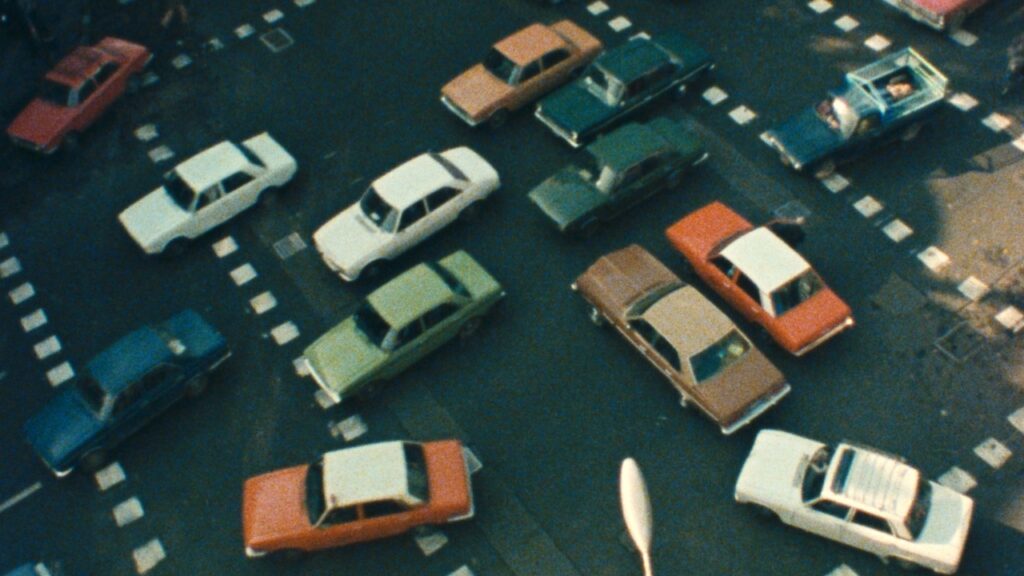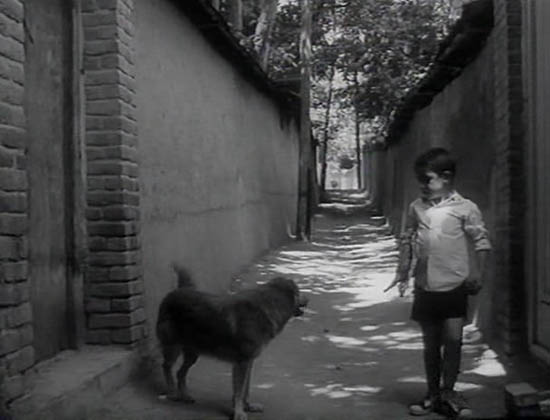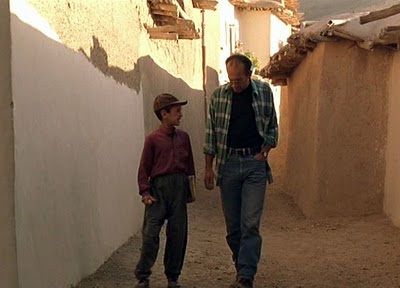From The Guardian (21 September 2002). I continue to find it frustrating that almost sixteen years later, what I regard as Kiarostami’s two best shorts, Two Solutions for One Problem (1975) and Orderly or Disorderly (1981), still aren’t available on any DVD or Blu-Ray (although Scott Perna has just emailed to remind me that the former can at least be accessed on YouTube). The principal reason was that Kiarostami himself didn’t like them. He once told me that even the second of these was made before he regarded himself as a film artist — something I continue to find baffling, and astonishing. But now that Criterion has announced that it will be restoring and releasing all his films, this lack of availability will apparently change. — J.R.
The eight short films made by Abbas Kiarostami between 1970 and 1982 offer an interesting riposte to critics who claimed during those years that they knew what was going on in world cinema. Even in Iran, where the shorts were made, none constituted much of an event. And considering how deceptively modest they are, they probably never would have attracted much notice anywhere if their director hadn’t gone on to make a string of masterful features over the past 15 years (the most recent of which, Ten, is about to open here). Yet there’s nothing else in cinema quite like them.
All this only confirms that it’s preposterous to pretend that anyone can know the state of world cinema — unless, that is, we reduce “world cinema” to the films that get promoted, most of them idiotic. For too long, we have been letting our cultural commissars — producers, exhibitors, distributors, official and unofficial publicists (including critics) — dictate the limited range of choices we’re supposed to want.
Kiarostami’s simple yet profound early shorts (all but one of which are at the National Film Theatre in London next week) are a good example of the kind of cinema that typically falls between the cracks. They were all produced by a state organisation called Kanun, better known as the Centre for the Intellectual Development of Children and Young Adults, founded by the shah’s wife. Their director had been a commercial artist throughout the 1960s, starting out with posters and book jackets before graduating to TV commercials and designing films’ credit sequences. He was pushing 30 when the owner of an advertising agency that he had worked for, now the director of Kanun, invited him to help set up the organisation’s film unit in 1969.
Assigned to make educational films, Kiarostami wound up creating a particular kind of pedagogical cinema that was both experimental and playful, though he once said that he didn’t regard himself as a film artist when he made them. They played a substantial role in making films about children fashionable in Iran, though they weren’t always made for children. In fact, the last two films that he made for Kanun went out into the world in the early 1990s as grown-up art features, Close-up and And Life Goes On… The first of these, Kiarostami’s initial calling card in the west, contains no children at all.
A few of the shorts — Breaktime (also known as Recess, 1972), Two Solutions for One Problem and So Can I (both 1975), Orderly or Disorderly (1981) — are set wholly or partially inside schools, and nearly all qualify in some fashion as didactic works, comparable to what Bertolt Brecht called Lehrstücken, or learning plays. The only film missing from the NFT program — the least interesting and incidentally the most didactic — is the 1980 Toothache, explaining how and why kids should brush their teeth.
Working within such a framework, Kiarostami could reflect on the advantages of cooperation over conflict (in Two Solutions for One Problem), draw on animation (used briefly in So Can I) or abstraction (as in The Colours, 1976), comically raise philosophical questions about order and disorder (Orderly or Disorderly) or formal as well as social questions about sound (in The Chorus, 1982), and even explore how a man might roll a tyre down a highway (Solution, 1978) or a little boy with a loaf of bread get past an unfriendly dog.
The latter is the subject of Kiarostami’s first film, Bread and Alley (1970), drawn from an experience recounted by his brother Taghi (who was credited with the script), and choreographed to a jazz version of the Beatles’ Ob-la-di, Ob-la-da. His second film, Breaktime, follows a boy heading home from school after being ejected from class for breaking a window, and Kiarostami’s design background becomes apparent when an early intertitle appears neatly and eccentrically over a wall at the end of a school corridor.
Try to imagine Laurel and Hardy directed by Robert Bresson and you may get some notion of the hilarious performance style of Two Solutions for One Problem, a syncopated, deadpan grudge match between two schoolboys that ensues after one returns a borrowed book to the other with its cover torn. The camera lingers on the resulting damage, including a broken pencil, a ripped shirt and a split ruler, while an offscreen narrator explains whose possessions got destroyed; then the story begins again with the torn book cover being glued back by the guilty party, proposing a second solution to the problem.
Children imitate the movements of other creatures in matching shots in So Can I; contrasting forms of behaviour as seen at a school and a busy traffic intersection are the subject of Orderly or Disorderly. Other kinds of repetitions, parallels and contrasts recur in these shorts as formal principles as well as subjects. In Kiarostami’s subsequent features, where they’re no less central, they often wind up structuring the action.
In Where Is My Friend’s House? (1987), this entails running up and down a zigzagging hillside path; in the documentary Homework (1990) and the fiction film And Life Goes On… (1992) it consists partly of asking several people the same questions. In Through the Olive Trees (1994) it involves two amateur actors in a film comically blowing take after take.
Taste of Cherry (1997) follows a middle-aged man in a car repeatedly asking strangers to bury him if he succeeds in killing himself; The Wind Will Carry Us (1999) shows a brash media person in a remote Kurdish village repeatedly driving up a hill to receive calls on his mobile phone.
This form of patterning is often a way of posing questions, and I would argue that Kiarostami belongs to that tribe of film-makers for whom a shot is often closer to being a question than to providing an answer. The tribe includes John Cassavetes, Chris Marker, Otto Preminger, Jacques Rivette, Andrei Tarkovsky and Jacques Tati (in his last three features). All these film-makers confound many spectators by not providing the sort of narrative assurances they expect from cinema, and most of them have a particular predilection for what might be termed philosophical long shots and all the questions these imply.
The Colours recalls the abstract montages of Hollis Frampton’s Zorn’s Lemma in terms of its colour coding, but it also indulges violent fantasies involving cars, guns, little boys and paint. The Chorus, by contrast, explores sound and its absence in narrative terms, through the story of an old man who escapes urban noise and his granddaughter by turning off his hearing aid.
The most remarkable of the shorts, Orderly or Disorderly, shows boys leaving a classroom, heading for a water fountain and getting on a bus, then offers a cosmic overview of adults driving through a busy section of Tehran. Each action is shown twice, with the boys or adults behaving in an orderly or disorderly fashion, though the degree to which this is being staged or documented is teasingly imprecise — a kind of ambiguity that continues in Kiarostami’s work all the way up to Ten.
The difference is that whereas in the 1982 short Kiarostami was playfully foregrounding his work as a director, including his own instructions and comments to his crew in every take, in Ten, two decades later, he’s avowedly trying to make a film without any direction at all, comparing his own function to that of a football coach, and ringing a bell between sequences as if they were separate innings. In this new film, one might alternatively say he’s proceeding more like a journalist than like a teacher. But as Close-up demonstrated, few modern directors handle journalism so artfully and so ambiguously.
While Kiarostami was making his original and delightful early shorts, film critics elsewhere in the world were reminding their readers that the important contributions to world cinema all came from the US, South America, Europe, and Japan, with a few exceptions (generally one per continent — Satyajit Ray in India, Ousmane Sembene in Africa). China, Taiwan, Hong Kong, Korea, Egypt and Iran were written off as producing films strictly for their own inhabitants, with little to interest sophisticated cinephiles. Today, when a good many more films are clamouring for our attention, it seems reasonable to assume that we might be missing at least as much.
Jonathan Rosenbaum will introduce his selection of Abbas Kiarostami shorts on Wednesday at the NFT, London SE1






